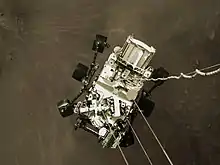| Discovery[1] | |
|---|---|
| Discovered by | MLS |
| Discovery site | Mount Lemmon Obs. |
| Discovery date | 8 April 2021 |
| Designations | |
| 2021 GW4 | |
| NEO–Apollo [2] | |
| Orbital characteristics[2] | |
| Epoch 2020-Dec-17 (JD 2459200.5) | |
| Uncertainty parameter 6 | |
| Observation arc | 4 days |
| Aphelion | 2.045 AU (305,900,000 km) (Q) |
| Perihelion | 0.97725 AU (146,195,000 km) (q) |
| 1.511 AU (226,000,000 km) (a) | |
| Eccentricity | 0.3532 (e) |
| 1.862 yr (678 days) | |
| 286.5° (M) | |
| Inclination | 0.73712° (i) |
| 201.52° (Ω) | |
| 6 May 2021 | |
| 26.568° (ω) | |
| Earth MOID | 0.00012 AU (18,000 km; 0.047 LD) |
| Jupiter MOID | 2.9 AU (430,000,000 km) |
| Physical characteristics | |
Mean diameter | 3–8 meters (CNEOS) |
| 29.5[2] | |
2021 GW4 is an Apollo near-Earth object roughly 5 meters (20 feet) in diameter. It was discovered by the Mount Lemmon Survey on 8 April 2021.[1] On 12 April 2021 13:01 UTC it passed 19821 km from the surface of Earth.[3] The uncertainty in the close approach distance was ±30 km.[4]
The Earth approach caused the asteroid to migrate inward and reduced the orbital period by roughly 71 days (from 678 days to 607 days).[5] As a result of the orbit change, it came to its next perihelion (closest approach to the Sun) on 6 May 2021.
Meteor scientist Peter Brown[6] and astronomers Jonathan McDowell[7] and Michael Busch[8] agree that the fireball near South Florida at 13 April 2021 2:16 UTC was unrelated to 2021 GW4. The unrelated fireball became visible at 100 kilometers (62 mi) above sea level and airburst at 37 kilometers (23 mi) before entering dark flight and landing in the Atlantic ocean.[6] Thousands of fireballs occur every day.[9]
References
- 1 2 "MPEC 2021-G121 : 2021 GW4". IAU Minor Planet Center. 9 April 2021. Retrieved 17 April 2021. (K21G04W)
- 1 2 3 "JPL Small-Body Database Browser: (2021 GW4)" (last observation: 2021-04-12; arc: 4 days; JPL #6). Jet Propulsion Laboratory. Retrieved 17 April 2021.
- ↑ 2021-Apr-12 Earth approach: 0.000175131 AU (26,199.2 km). 26199km "geocentric distance" – 6378km "Earth radius" = 19821km
- ↑ "Horizons Batch for 2021-Apr-12 13:01 showing RNG_3sigma uncertainty of ±29.7km". JPL Horizons. Retrieved 17 April 2021.
- ↑ Horizons output. "Orbital Elements for Asteroid (2021 GW4)". Retrieved 17 April 2021. ("Ephemeris Type" select "Orbital Elements" · "Center" should already be set for "Sun (body center)" (aka @sun) · "Time Span" I selected "2020-Dec-17" to match the current JPL SBDB numbers and "2021-Jun-17" with a step size of 6 months.)
- 1 2 Meteor scientist Peter Brown
- ↑ Astronomer Jonathan McDowell
- ↑ Astronomer Michael Busch
- ↑ "Fireball FAQS: How frequently do fireballs occur?". American Meteor Society. Retrieved 17 April 2021.
External links
- 2021 GW4 at NeoDyS-2, Near Earth Objects—Dynamic Site
- 2021 GW4 at ESA–space situational awareness


